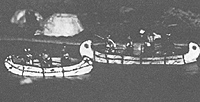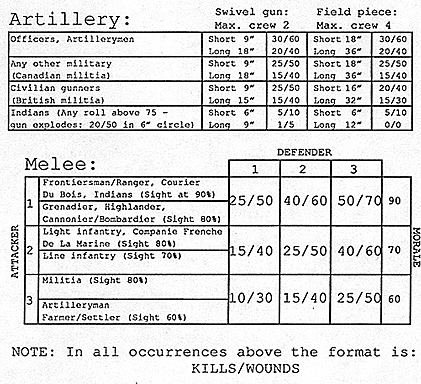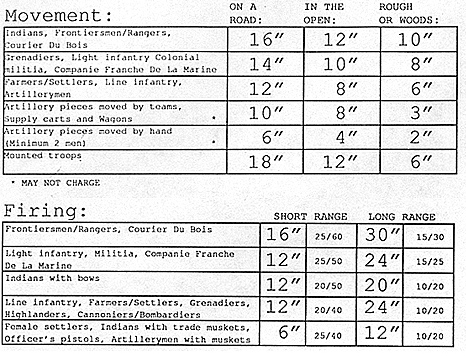 Miniature figures represent individuals. Percentage dice are used for resolution of combat and morale. In one turn, an individual may MOVE the full distance allowed according to terrain and troop type, or SIGHT AND FIRE at full effect, or MOVE one-half distance while FIRING at one-half ability or perform a difficult TASK (such as climb a river bank, scale a wall, etc.) or CHARGE.
Miniature figures represent individuals. Percentage dice are used for resolution of combat and morale. In one turn, an individual may MOVE the full distance allowed according to terrain and troop type, or SIGHT AND FIRE at full effect, or MOVE one-half distance while FIRING at one-half ability or perform a difficult TASK (such as climb a river bank, scale a wall, etc.) or CHARGE.
MOVEMENT
Random alternating move sequence within one turn by regimental group or tribe (or individuals, if a small skirmish using less than a dozen figures per side) is determined by dice throw or drawn cards (unit or individual names/ numbers may be written on index cards to be shuffled between every turn). Compare troop type against the listed terrain type for the maximum number of inches that may be moved in one turn. An attempt to cross any obstacle halves movement and requires a successful morale/ability roll to traverse them.
Rough terrain types: Ploughed/in crop fields, broken ground, slopes, stream fords, unopposed stairs, ladders or windows and building interiors.
Rough terrain rated as obstacles: Walls, barricades, fallen trees/abatis, leaving river fords, opposed ladders, windows, etc.
Canoe movement: Determine the direction and speed of the water's current (number of inches times one 10-sided die). The current may be variable in stretches around bends or through designated rapids if the referee or players desire. The base speed for a single man paddling a canoe is 6" per turn with the addition of 4" per additional paddler to a maximum of 3 (size of canoe permitting), eg., the maximum base speed for a large canoe with 4 people paddling would be 18" (6" + 3 x 4" =18"). If going upstream, subtract the current rate from the base rate; if going downstream, add the current rate to the base rate. Wounded men paddle at 1/2 efficiency (i.e., 2", not 4"). It takes one turn to pull into the hank and disembark or to climb in and shove off. All fire from canoes is treated as MOVING AND FIRING. An individual may fire OR paddle. To avoid striking rocks in rapids or to negotiate hairpin turns without capsizing, make a success roll (using the skill of the lowest team member). To avoid drowning if this fails make a DIFFICULT success roll at 1/2 ability per individual.
Artillery movement: Artillery may, in one turn: LIMBER or UNLIMBER or MOVE or FIRE or CHANGE FACING a maximum of 90 degrees and fire at 112 effect.
TO CHARGE
1. A charge must be declared against an objective/area or specific body of troops.
2. Must be made in or into clear terrain. Those charging must make a successful morale roll to carry through and, if they do, may add 3" to their movement and +10 to their melee ability on the first turn of impact (troops charging a low wall, prepared position or woods edge still receive the 3" bonus, but lose their +10 due to lack of impetus from having to scramble over the wall, undergrowth, etc.). Mark the farthest point the charging unit could reach and roll morale for the defending unit to stand; if they do melee occurs at their position. If either unit fails it will drop back 6" from the point of impact and may not initiate any combat, defending only if attacked. If a countercharge is made, units will impact at the midpoint of the respective charges. If a unit fails to stand, a successful charging unit has the option to pursue (and possibly overtake) the retreating unit as long as it has movement remaining. Morale checks may be rolled individually oras a group as the player desires. Charging units may not fire.
FIRING
Sighting and firing arc is 180 degrees to the front. Sighting and firing sequence is random alternating as in movement. Line and Light infantry, Grenadiers, Companie Franche De La Marine and British militia may fire 2 ranks deep if playing games using large bodies of troops. Use sighting ability chart to see an enemy making an action in cover, use at 1/2 ability if the enemy is not moving. You must sight an enemy to fire (i.e., no blind shooting).To sight an enemy in a forest, you must be physically in the same forest or move to the edge to look in. You must roll to sight for firing at opponents in forests (not rough, though physical cover in rough still halves the firing factor) and behind blockhouse slits and windows. If enemies are touching opposite sides of the same wall (house, fort, palisade) and want to fire while hugging cover -- both fire at 1/2 effect; if either side leans out to get a clear shot -- both fire at full effect. This does not apply to small loopholes where a defender may not be fired upon while firing (the referee may grant an adjacent attacker a small percentage chance to snatch the protruding musket from the loophole and disarm the defender).
Reference troop type vs. range for the numbers needed to roll on percentage dice; the top number kills, the bottom number wounds; any number higher is a miss. Wounds cause all movement, abilities and morale to be halved. Two wounds are equivalent to a kill and remove the piece from play (for small games, the players may wish to halve abilities again for each additional wound and keep that piece in play). An unobstructed line of sight from head to head is required for a normal shot. Firing at an enemy in forest or partially concealed in a window, embrasure, etc., halves all chances.
Artillery fire: The arc of fire is 90 degrees and attacks and ranges are resolved according to the highest ranking gunner or officer. Targets must be adjacent within 6" at short range (i.e., 3" to either side of the nominated target figure) or within 3" at long range to be considered a target.
Artillery was mainly used for bombarding positions and opening breaches and was not the more mobile anti-personnel weapon of later wars. To reflect its erratic nature, the number of attacks that will be permitted will be determined upon the actual firing of the gun. Swivel guns roll for one tensided die of attacks at short range, 1/2 for long range. Field pieces get 2 tensided dice at short range and one at long range. Attacks are then resolved on the first nominated target until it is dead and then proceed to the next victim until there are no more targets or shots remaining. A swivel gun requires a crew of 2; a field piece, a crew of 4. Fewer people may man the gun, but reduce the actual number of attacks by the percentage of missing crew members, rounding up. Example: A field piece has one gunner killed just before firing at short range. Two ten-sided dice total 12 possible attacks, but 1/4 are lost due to the disruption of the gun drill, so only 9 attacks are permitted.
Wall guns are simply large stationery muskets on a swivel which fire as field pieces but are allowed only one attack.
Troops fired on bya rtillery must make a successful morale check or retreat a full move toward the nearest cover (they may roll for rally every turn).
Breaching wall, positions or doors by artillery: Players must decide if a door or wall is flimsy or stout and how many "kills" it takes to breach same. Flimsy cabin doors take wounds as kills; stout blockhouse doors or fort gates are only damaged by kills.
Breaching doors by physical force: Flimsy doors can be forced by shoulder and defended by same. Stout doors are usually cross barred and a log or ram will be required to assault them. These attacks are conducted as melee push backs for resolution. Undefended barred doors use the farmer chart as a defense roll.
MELEE
Melee is simultaneous and is conducted by all opposing figures who are base to base or adjacent to the same section of ladder, wall, etc. (it is assumed that one of the players is attempting to initiate combat while climbing over said wall). Each player who is facing an opponent of equal or higher rank must make a successful morale throw to stand and fight; failure to close means the figure must drop back 6" to avoid the combat (this may not be enough to carry a retreating figure out of the way of a declared charge).
If a player is attempting to escape melee (by choice or failed morale) he must suffer a free attack upon him at 112 his opponent's normal ability before he can complete the retreat. All those left to melee cross reference the attacking troop type vs. the defending troop type and roll percentile dice. Results apply as per the firing chart. Players remain in melee through successive turns until one is killed or runs away.
Melee pushbacks: If a player wounds his opponent and is unwounded he may maneuver said opponent 2" in any reasonable direction, including off walls, ladders, etc.). If both are wounded or both miss, the person rolling closest to the needed number may pet-form the pushback.
MORALE CHECKS
Must be made when a unit: CHARGES, STANDS AGAINST A CHARGE, IS FIRED UPON FROM THE REAR, TAKES CASUALTIES FROM ARTILLERY FIRE, 15 REDUCED BELOW HALF STRENGTH, or PERFORMS AN ACTION BEING OPPOSED BY AN ENEMY PLAYER.


Back to Table of Contents -- Courier Vol. VIII No. 3
To Courier List of Issues
To MagWeb Master Magazine List
© Copyright 1988 by The Courier Publishing Company.
This article appears in MagWeb (Magazine Web) on the Internet World Wide Web.
Other military history articles and gaming articles are available at http://www.magweb.com